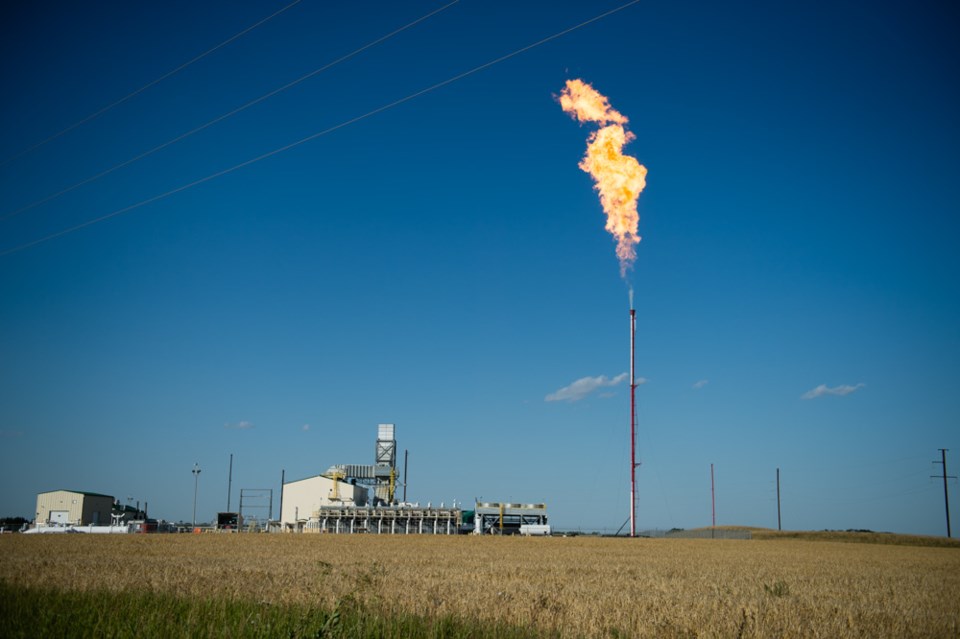����������岹��– A plant operational upset at Keyera’s Simonette gas plant, located 60 kilometres southwest of Valleyview, Alta., led to the complete shutdown of the Alliance Pipeline system in early August.
On Aug. 6, Alliance Pipeline advised in a press release, “An amount of hydrogen sulfide (H2S) entered into its mainline pipeline system as a result of complications experienced by an upstream operator.”
The next day the pipeline company met with stakeholders, stating in a release, “Alliance is carefully and safely managing the situation. In order to correct the situation Alliance is commencing mitigation activities which are expected to result in a zero flow condition on the pipeline. It is anticipated that this will begin impacting commercial stakeholders mid-morning on August 7, 2015 and will continue for an indeterminate amount of time.
“The H2S has been isolated in a section of the Alliance mainline where it will safely remain until it is removed through the flaring process.”
As part of this, Alliance flared the impacted natural gas in order to safely dispose of it, commencing flaring at two locations. The first, started Aug. 9, was at a block valve near Arcola. The second, at the Alameda compressor station, commenced Aug. 10. Multiple flares were used at each site.
The Alameda compressor station is located six kilometres north of Alameda and 1.6 kilometres west of Highway 9, at 4-25-4-3-W2.
The flare stacks used at Alameda were 30 metres in height, and the flame was nearly that height again. The sound was deafening, akin to standing near a jetliner about to take off.
“Our chief concern now is to ensure the safety of the public, employees and the environment. We are working to remove the H2S from the pipeline in a controlled and safe manner,” said Daniel Sutherland, Alliance’s vice-president, commercial operations. “We apologize for any inconvenience this may cause to our customers and we are working with our partners and the regulator to determine the cause.”
By Aug. 11, Sutherland said, “Our flaring operation is on track and the amount of hydrogen sulphide in the small segment of pipeline is С����Ƶ reduced to a safe level. Our monitoring indicates that all ambient air quality standards continue to be met.”
Alliance spokesperson Tony Straquadine explained to Pipeline News that they tracked the H2S as it moved through the system, isolating it to a section in southeast Saskatchewan. He noted that was the best location to do the flaring, in a rural area.
Asked why the concentration of H2S, mixed with gas from over 60 other gas plants, wouldn’t have simply been diluted to the point of С����Ƶ a non-issue, Straquadine replied, “In a large pool, you’d think it mixes together.”
However, a pipeline is not a large pool, and the H2S contamination meant the gas in the line no longer met the specifications for gas the pipeline needed to deliver downstream.
Alliance is a sweet system, Straquadine explained.
While he noted many upstream users of the pipeline have alternative shipping paths, with dual or multiple connections, that has not been the case for all. Indeed, a ripple effect was felt throughout the region Alliance collects from. The National Post noted, “Seven Generations, Athabasca Oil Corp., Crew Energy Inc., RMP Energy Inc, NuVista Energy Ltd. and other producers announced they were temporarily suspending or reducing their natural gas production in northwestern Alberta as a result.”
Seven Generations Energy Ltd. said in a release on Aug. 7, “This suspension will result in a deferral of essentially all of Seven Generations’ production until the situation is resolved. 7G intends to use this temporary event to conduct maintenance of its production and processing facilities.”
Some companies took advantage of the downtime by performing maintenance
Keyera’s press release of Aug. 7 noted, “There was no risk to the public or to the environment as a result of this upset. However, gas which did not meet sales gas specifications entered the Alliance Pipeline system.
“We have offered our assistance to Alliance Pipeline and are working with our producer customers to divert gas and find alternative solutions for their production until regular operations resume on Alliance.
The raw gas that comes into the Simonette plant is usually about 0.6 per cent sour on average, based on various inlets that feed the plant, according to Keyera’s Nick Kuzyk, manager of investor relations.
The Alliance Pipeline was constructed in 1999 and 2000, and collects almost all of its gas from northeastern British Columbia and northwestern Alberta. However, it does have a delivery receipt point in Saskatchewan from the Steelman gas plant, which is just a few kilometres west of the Alameda compressor station. There is also a lateral that runs from Tioga, North Dakota, to the mainline just south of where it crosses the Canada/United States border south of Gainsborough. The pipeline’s delivery point is the Aux Sable natural gas liquids and extraction facility at Channahon, Illinois, which is about 80 kilometres southwest of Chicago. All the gas delivered via the Alliance Pipeline is processed at ASLP’s Channahon NGL Facility.
Aux Sable states it is one of the largest NGL extraction and fractionation facilities in North America.
To replace natural gas lost as a result of the flaring process, and to increase the pressure to expedite the flow in the pipeline, Alliance issued a request to existing shippers for purchase of up to 400 million cubic feet of natural gas. As Alliance acquired and received the natural gas, it began a carefully controlled restart of the pipeline and achieve the targeted resumption of service on Thursday, August 13.




